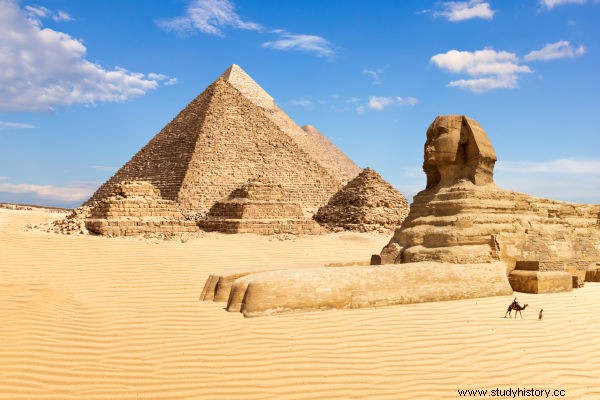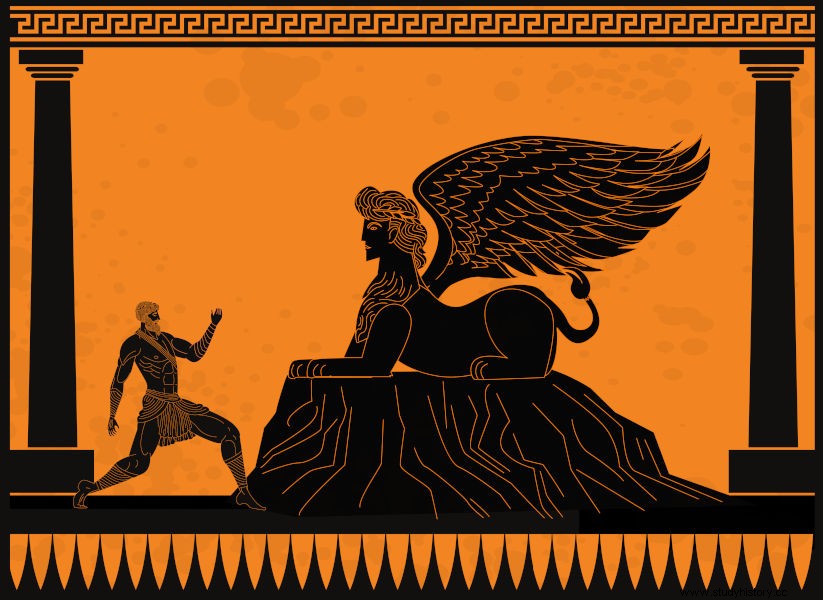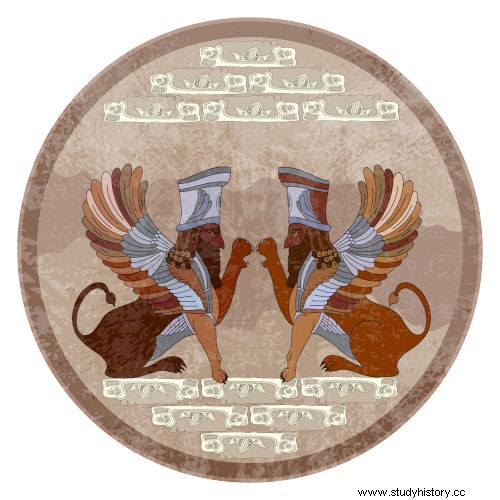
The sphinx was a mythological being present in several cultures of antiquity. The Egyptians believed that sphinxes were spiritual guardians of the places where they were built, and the Greeks believed that they were monsters that devoured humans. In general, sphinxes were portrayed with a lion's body and a human face, whether male or female.
Access also :The Gods of Religiosity of the Ancient Greeks
Sphinx Summary
-
Sphinxes are mythological beings present in the culture of different ancient peoples.
-
They are believed to have originated in Egyptian culture, although it is not known exactly when.
-
They were portrayed as beings with the body of a lion, a human face and, in some cases, wings.
-
The best known Egyptian sphinx is that of the Pyramids of Giza
-
They were also present in Greek, Minoan, Mycenaean, Assyrian, Persian cultures, among others.
Sphinx in Antiquity
The sphinx was a being present in the mythology of different peoples of antiquity. It is traditionally known for its presence in Egyptian architecture and Greek mythology , but it was also present in the culture of several peoples, such as the Mycenaeans, Cushites, Cretans, Assyrians, Persians, among others.
Because of this, your meaning could be distinct in these different cultures. Another important point is that its form also varied according to the place where it manifested itself. In general, sphinxes were represented with lion body and face human, that could be female or male . Sometimes they could be depicted without a human face and with wings .
The name “sphinx” is derived from the Greek language and therefore we refer to this mythological being as the Greeks referred to it. It is believed that the Greeks coined this name in reference to the word shesep-ankh , which, in the ancient language of the Egyptians, meant "living image." This word was used to refer to statues built in the very place where they would be exposed.
Sphinx in Egypt
Historians point out that the sphinx probably appeared in Egypt, although it is not known when this happened.|1| Egyptian sphinxes were represented as a lion with a male face, usually the face of a pharaoh. The face was adorned with a menés, a kind of headdress that the Egyptian pharaohs wore.
Sphinxes were seen as guardians spiritual in Egyptian culture. The best-known sphinx, which was built by the Egyptians, is Great Sphinx of Giza . It is believed to have been built around 2500 BC, during the fourth dynasty of Egypt. Some historians point out that she may be older than that, but substantial evidence to support this theory is still lacking.
From the New Kingdom, the Sphinx of Giza became related to Horus , being known as Horemakhet , term meaning “Horus on the horizon”. Thus, this sphinx became a place of worship to this god, and a temple was built on it by the pharaohAmunhotep II , who reigned over Egypt from 1425 BC. to 1401 BC
Amenhotep II's successor, his son Thutmose IV, was also responsible for a major restoration work on the Great Sphinx of Giza, ordering the removal of the sand that covered part of it and building a stele between the paws of the monument. This was done because, supposedly, Thutthemes had dreamed of the sphinx, and during the dream, she would have asked for the sand to be taken from her, giving him the throne of Egypt in exchange.
The Great Sphinx of Giza is known for its gigantic dimensions, measuring 73 meters long and 20 meters high .
Login also :The religion practiced by the ancient Egyptians
Sphinx in Greece

As we have seen, the sphinx is a mythological being that also was present in the culture of the ancient Greeks. Its presence in Greece dates back to the period P re- H omeric , since there were representations of sphinxes in cultures Minoan (also known as Cretan or Minoan) and Mycenaean . Studying both, archaeologists have discovered artifacts, such as ceramic objects and frescoes, stamped with sphinx designs.
In the context of the classical culture of the Greeks, the sphinx was present in a myth . The Greeks considered it a being monstrong , regarded as a kind of demonic being that harmed people. In general, the Greeks reproduced the sphinx as a being with a lion's body, wings and a female face.
The Greeks believed that the sphinx was the daughter of Chimera , a monster that breathed fire from its nostrils and that possessed lion, goat, snake, and dragon parts; and from Orthros , a two-headed dog. The presence of the sphinx in Greek culture was mainly linked to the myth of Oedipus , moreover, it meant the arrival of death and destruction to the place where it was installed.
Greek mythology tells that the sphinx has arrived at Thebes bringing famine into the city and barring all who headed for it. She announced that she would only release the men who solved the riddle she would propose. However, none of the men could solve the riddle, and so they were devoured by the monster.
Finally appeared Oedipus, son abandoned by a king of Thebes named Laius. Oedipus came forward to answer the riddle, and the sphinx asked the question:
“— Which animal walks on four feet in the morning, two feet in the afternoon, and three feet in the evening?
Oedipus' answer was:
— It is the man, who crawls in childhood, walks upright in youth and with the help of a stick in old age.”|2|
Oedipus' answer killed the sphinx's riddle , who, in shame, jumped off a cliff to her death. Oedipus was then crowned king of Thebes. Some versions of the legend present that the sphinx proposed two riddles to him and that, in fact, she did not kill herself, but was killed by the king's son.
The earliest depictions of the Oedipus and Sphinx myth in Greek artifacts are believed to date back to the 6th century BC, although the earliest sphinxes were depicted around the 7th century BC. Their representations could be found on building columns and small sculptures that were often used as offerings in some shrines.
One of the most famous sphinxes in Greece was found in a sanctuary in Delphi. In addition, the Greeks reproduced sphinxes on funerary stelae and in small fountains.
-
Video Lesson on Ancient Greece:Pre-Homeric Period
Sphinxes elsewhere
As mentioned, sphinxes are mythological beings found in the cultures of different peoples of antiquity. In regions of South and Southeast Asia, such as India, there were mythological beings that had a part lion, part human body. The presence of the sphinx at these sites is believed to have beenthe result of the influence of Hellenistic art .
Also, Persian art manifested depictions of sphinxes, but the Persians portrayed this being with a male face, as did the Egyptians. For thePersians , the sphinxes served as protection against evil spirits . Large Persian cities such as Susa and Persepolis had sphinxes depicted in different locations.

Peoples of Mesopotamia such as the Assyrians , believed in a deity called Lamassu , and its representation had great similarities with the Greek and Egyptian sphinxes. Despite this, some differences can be traced between the goddess Lamassu and the sphinx. The latter is always represented as a lying lion, while the former was represented standing, for example.
Other peoples who portrayed sphinx-like beings were the Elamites , Hittites etc. Sphinxes are also present in Renaissance works as a result of the influence of Greco-Roman culture on the art of this period.
Notes
|1| Sphinx. To access, click here [in English].
|2| BULFINCH, Thomas. The Golden Book of Mythology . Rio de Janeiro:Ediouro, 2006. p. 128.
